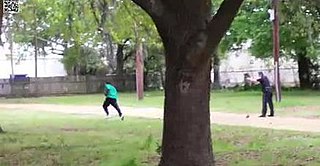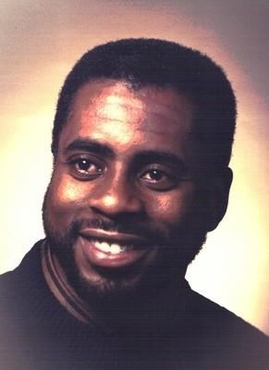Related Research Articles
On December 22, 1984, Bernhard Goetz shot four young black men on a New York City Subway train in Manhattan after they tried to rob him. All four teenagers survived, though one, Darrell Cabey, was paralyzed and suffered brain damage as a result of his injuries. Goetz fled to Bennington, Vermont, before surrendering to police nine days after the shooting. He was charged with attempted murder, assault, reckless endangerment, and several firearms offenses. A jury subsequently found Goetz guilty of one count of carrying an unlicensed firearm and acquitted him of the remaining charges. For the firearm offense, he served eight months of a one-year sentence. In 1996, Cabey obtained a $43 million civil judgment against Goetz, equivalent to $84 million today.

Brian Gene Nichols is a convicted murderer known for his escape and killing spree in the Fulton County Courthouse in Atlanta, Georgia, on March 11, 2005. Nichols was on trial for rape when he escaped custody and murdered the judge presiding over his trial, a court reporter, a Fulton County Sheriff's deputy, and later an ICE special agent. Twenty-six hours after a large-scale manhunt was launched in the metropolitan Atlanta area, Nichols was taken into custody. The prosecution charged him with committing 54 crimes during the escape; he was found guilty on all counts on November 7, 2008 and was subsequently sentenced to life in prison.
The 1982 Wilkes-Barre shootings was a spree shooting which occurred in the United States on September 25, 1982, carried out by George Emil Banks, a former Camp Hill prison guard. Banks fatally shot 13 people in Wilkes-Barre and Jenkins Township, Pennsylvania. The victims included seven children – five being his own – their mothers, some of their relatives, and one bystander.

Kathryn Johnston was an elderly woman from Atlanta, Georgia who was killed by undercover police officers in her home on Neal Street in northwest Atlanta on November 21, 2006, where she had lived for 17 years. Three officers had entered her home in what was later described as a 'botched' drug raid. Officers cut off burglar bars and broke down her door using a no-knock warrant. Police said Johnston fired at them and they fired in response; she fired one shot out the door over the officers' heads and they fired 39 shots, five or six of which hit her. None of the officers were injured by her gunfire, but Johnston was killed by the officers. Police injuries were later attributed to friendly fire from each other's weapons.

State of Nevada v. Orenthal James Simpson, et al, Case Number: 07C237890-4. was a criminal case prosecuted in 2007–2008 in the U.S. state of Nevada, primarily involving the retired American football player O. J. Simpson.

Oscar Grant III was a 22-year-old African-American man who was killed in the early morning hours of New Year's Day 2009 by BART Police Officer Johannes Mehserle in Oakland, California. Responding to reports of a fight on a crowded Bay Area Rapid Transit train returning from San Francisco, BART Police officers detained Grant and several other passengers on the platform at the Fruitvale BART Station. BART officer Anthony Pirone kneed Grant in the head and forced Grant to lie face down on the platform. Mehserle drew his pistol and shot Grant. Grant was rushed to Highland Hospital in Oakland and pronounced dead later that day. The events were captured on bystanders’ mobile phones. Owners disseminated their footage to media outlets and to various websites where it went viral. Both protests and riots took place in the following days.

On the morning of September 4, 2005, six days after Hurricane Katrina struck New Orleans, members of the New Orleans Police Department (NOPD), ostensibly responding to a call from an officer under fire, shot and killed two civilians at the Danziger Bridge: 17-year-old James Brissette and 40-year-old Ronald Madison. Four other civilians were wounded. All the victims were African-American. None were armed or had committed any crime. Madison, a mentally disabled man, was shot in the back. The shootings caused public anger and further eroded the community's trust in the NOPD and the federal response to Hurricane Katrina overall.

Aiyana Mo'Nay Stanley-Jones was a seven-year-old girl from Detroit's East Side who was shot in the neck and killed by police officer Joseph Weekley during a raid conducted by the Detroit Police Department's Special Response Team. The Team was targeting a suspect in the apartment a floor above Jones' on May 16, 2010. Her death drew national media attention and led U.S. Representative John Conyers to ask U.S. Attorney General Eric Holder for a federal investigation into the incident.
Jesus C. Gonzalez is an American man from Milwaukee, Wisconsin, known for a gun rights civil lawsuit, as well as being convicted of a reckless homicide shooting.

The death of Sammy Yatim occurred early in the morning of July 27, 2013, in Toronto, Ontario, Canada. Yatim, an 18-year-old Toronto male armed with a switchblade knife, was shot at nine times, and was hit by eight of the shots fired by 30-year-old Toronto Police Service (TPS) officer James Forcillo. After being shot, while lying on the floor of the streetcar he was tasered. He later died from the injuries. The incident occurred after Yatim, brandishing a 12 cm (4.7 in) switchblade knife in a Toronto streetcar, advanced on a passenger, threatened other passengers, and exposed himself. The confrontation between Yatim and the police was recorded and footage of it was released publicly, prompting strong reactions across Canada.
Akai Gurley, a 28-year-old black man, was fatally shot on November 20, 2014, in Brooklyn, New York City, United States, by a New York City Police Department officer. Two police officers, patrolling stairwells in the New York City Housing Authority (NYCHA)'s Louis H. Pink Houses in East New York, Brooklyn, entered a pitch-dark, unlit stairwell. Officer Peter Liang, 27, had his firearm drawn. Gurley and his girlfriend entered the seventh-floor stairwell, fourteen steps below them. Liang fired his weapon; the shot ricocheted off a wall and fatally struck Gurley in the chest. A jury convicted Liang of manslaughter, which a court later reduced to criminally negligent homicide.

On April 4, 2015, Walter Scott, a 50-year-old black man, was fatally shot by Michael Slager, a local police officer in North Charleston, South Carolina, United States. Slager had stopped Scott for a non-functioning brake light. Slager was charged with murder after a video surfaced showing him shooting Scott from behind while Scott was fleeing, which contradicted Slager's report of the incident. The racial difference led many to believe that the shooting was racially motivated, generating a widespread controversy.
Daniel Ken Holtzclaw is a former police officer in the United States. He was convicted in December 2015 of multiple counts of rape, sexual battery, and other sex offenses while working for the Oklahoma City Police Department.

The murder of Laquan McDonald took place on October 20, 2014, in Chicago, Illinois. McDonald was a 17-year-old who was fatally shot by a Chicago Police Officer, Jason Van Dyke. Police had initially reported that McDonald was behaving erratically while walking down the street, refusing to put down a knife, and that he had lunged at officers. Preliminary internal police reports described the incident similarly, leading to the shooting being judged as justifiable, and Van Dyke not being charged at the time. This was later disproved after a video of the encounter was released, showing that McDonald was walking away.
In the late evening of January 7, 2016, in a sudden attack with no precipitating event, Edward Archer rushed towards and shot Philadelphia police officer Jesse Hartnett while he drove his patrol car, inserting the gun into the window of the car and firing at point blank range. Despite being shot multiple times in the left arm, Hartnett was able to exit his car and shoot the fleeing suspect. Later in the hospital, Archer claimed he pledged allegiance to ISIS. The Federal Bureau of Investigation (FBI) investigated the shooting as a terrorist attack.
The shooting of Anthony Hill, a U.S. Air Force veteran, occurred on March 9, 2015, in Chamblee, Georgia, near Atlanta. Hill, fatally shot by police officer Robert Olsen, suffered from mental illness and was naked and unarmed at the time of the incident. The incident was covered in local and national press and sparked the involvement of Black Lives Matter and other advocacy groups who demonstrated their anger at the shooting. In January 2016, a grand jury indicted officer Olsen on two counts of felony murder and one count of aggravated assault. Nearing the fourth anniversary of the homicide, it was decided that Olsen's trial would be rescheduled for September 23, 2019, with delays including three successive judges having recused themselves in the case.
On April 29, 2017, Jordan Edwards, a 15-year-old African-American boy, was murdered by police officer Roy Oliver in Balch Springs, Texas, within the Dallas-Fort Worth metroplex. Edwards was shot in the back of the head while riding in the front passenger's seat of a vehicle driving away from officers that attempted to stop it. He was unarmed during the encounter.
Anthony Lamar Smith was a 24-year-old African American man from St. Louis, Missouri, who was shot and killed by then St. Louis Police officer Jason Stockley following a car chase on December 20, 2011. On September 15, 2017, Stockley was found not guilty of first-degree murder, and protests erupted in St. Louis.

Atatiana Koquice Jefferson, a 28-year-old woman, was fatally shot inside her home by a police officer in Fort Worth, Texas, United States, in the early morning of October 12, 2019. Police arrived at her home after a neighbor called a non-emergency number, stating that Jefferson's front door was open. Police body camera footage showed officers walking outside the home with flashlights for a few minutes then one officer yells, "Put your hands up! Show me your hands!", while discharging his weapon through a window. Police found a handgun near Jefferson's body, which according to her eight-year-old nephew, she was pointing toward the window before being shot. On October 14, 2019, Officer Aaron Dean, the shooter, resigned from the Fort Worth Police Department and was arrested on a murder charge. On December 20, 2019, Dean was indicted for murder. Jefferson was black and the officer who shot her is white, prompting news outlets to compare Jefferson's shooting to the September 2018 murder of Botham Jean in nearby Dallas.

The killing of Greg Gunn occurred on the morning of February 25, 2016, in Montgomery, Alabama. Gunn, a 58-year-old African-American man, was shot and killed near his home after fleeing from a stop-and-frisk initiated by Aaron Cody Smith, a white police officer. Smith was charged with murder and indicted by a grand jury in 2016. The case came to trial in late 2019 following a change of venue to Ozark, Alabama. Smith was found guilty of manslaughter, and, in January 2020, was sentenced to 14 years in prison.
References
- 1 2 3 4 "Rail officer charged in cop shooting". Chicago Tribune . 23 February 2005. ProQuest 420358588.
- ↑ Sfondeles, Tina (29 January 2012). "Ex-cop guilty of trying to kill four officers during traffic stop". Chicago Sun-Times . Retrieved 5 April 2012.
- 1 2 3 4 5 Savodi, Carlos (13 May 2007). "Jury hung in railroad cop's shooting trial". Chicago Tribune. ProQuest 420579213.
- 1 2 3 4 5 Muhammad, Starla (9 February 2012). "Black ex-cop shot 28 times by White cops is found guilty, fights for justice". The Final Call . Retrieved 5 April 2012.
- 1 2 3 "Highest Honors Bestowed on Police Department's Bravest at Annual Awards Ceremony" (PDF). Chicago Police Department. 10 May 2006. Archived from the original (PDF) on 16 April 2012. Retrieved 5 April 2012.
- 1 2 3 4 5 6 McCain, Delores (9 May 2007). "Morgan trial hears from witness: Prosecutors make an issue of 1997 EEOC lawsuit". Austin Weekly News. Archived from the original on 21 April 2012. Retrieved 5 April 2012.
- 1 2 3 4 5 6 7 Pearson, Ted (29 January 2012). "Howard Morgan, shot 28 times by police, found guilty!". Political Affairs. Retrieved 5 April 2012.
- ↑ Charles, Thomas (22 November 2005). "Man shot 25 times by police is released from jail". ABC Local News. Retrieved 5 April 2012.
- ↑ Muhammad, Ashahed M. (1 June 2007). "Mistrial declared for former cop shot 28 times by police". The Final Call . Retrieved 5 April 2012.
- 1 2 English, H. Scott (29 January 2012). "Chicago Cop Shot 28 Times Then Convicted Of Attempted Murder". The Inquisitr. Retrieved 5 April 2012.
- ↑ Muhammad, Judith; Yolanda Muhammad (26 April 2005). "Howard Morgan fights for his life". Final Call. Retrieved 5 April 2012.
- 1 2 Jones, Arlene (13 October 2010). "Payback time for judge who set outrageous bail". http://www.austinweeklynews.com/main.asp?SectionID=3&SubSectionID=3&ArticleID=2987 . Retrieved 5 April 2012.
{{cite news}}: External link in|newspaper= - ↑ "Railroad cop's bail stays at $2 million". Chicago Tribune. 21 September 2005. ProQuest 420454235.
- 1 2 3 4 McCain, Delores (16 May 2007). "Morgan case ends in mistrial: Reportedly, 10 of 12 jurors voted not guilty". Austin Weekly News. Retrieved 5 April 2012.
- 1 2 3 Lynch, La Risa (1 February 2012). "Howard Morgan - guilty: Verdict against former detective shot by Chicago police 28 times". Austin Weekly News. Retrieved 5 April 2012.
- 1 2 3 Lynch, La Risa (22 February 2012). "Attorneys for convicted ex-cop seek new trial: Sentencing for Howard Morgan delayed until April 5". Austin Weekly News. Retrieved 5 April 2012.
- 1 2 3 4 McBride; Cahill; Gordon (28 August 2009). "The People of the State of Illinois v. Howard Morgan" (PDF). Appellate Court of Illinois, First Judicial District. Retrieved 5 May 2012.
- 1 2 Fitzpatrick, Lauren (5 April 2012). Chicago Sun-Times http://www.suntimes.com/news/11730457-418/man-shot-28-times-by-chicago-cops-gets-40-years-in-prison.html . Retrieved 5 April 2012.
{{cite news}}: Missing or empty|title=(help) - 1 2 Mitchell, Mary (2 April 2012). "MARY MITCHELL: Chicago has its own Trayvon Martin-like scandal". Chicago Sun-Times . Retrieved 5 April 2012.
- ↑ rmperrotta (4 April 2012). "Thurs April 5, 8am: Free Howard Morgan Demo at Cook County Courthouse!". Blog. Occupy Chicago. Archived from the original on 15 April 2013. Retrieved 5 April 2012.
- 1 2 Muhammad, Cinque (18 April 2012). "After suffering 28 bullet wounds from cops, Howard Morgan sentenced to 40 years". The Final Call. Retrieved 5 May 2012.
- ↑ Vatis, Kim (5 April 2012). "40 Years for Man Shot 28 Times by Police: Morgan supporters say the decision is racially charged". NBC Chicago. Retrieved 5 April 2012.
- ↑ St. Clair, Stacy; Mills, Steve (12 January 2015). "Quinn commutes sentences of 2 men with shaky murder convictions". Chicago Tribune. Retrieved 13 January 2015.
- ↑ Meincke, Paul (14 January 2015). "HOWARD MORGAN RELEASED FROM PRISON AFTER QUINN COMMUTES 40-YEAR SENTENCE". ABC 7 Chicago. Retrieved 16 January 2015.
- ↑ "Howard Morgan Sentencing". News Feed. Fraternal Order of Police: Chicago Lodge 7. 3 April 2012. Archived from the original on 8 April 2012. Retrieved 5 April 2012.
- ↑ Rowe, Amir (4 April 2012). "Are They Kidding? Man Shot 28 Times By Police Faces Sentencing! (VIDEO)". Global Grind. Retrieved 5 April 2012.
- ↑ "Howard Morgan, Black Off-Duty Cop Shot 28 Times By White Chicago Officers, Faces Sentencing". Huffington Post . 3 April 2012. Retrieved 5 April 2012.
- ↑ The Free Howard Morgan Campaign. "Free Howard Morgan" . Retrieved 2014-12-06.